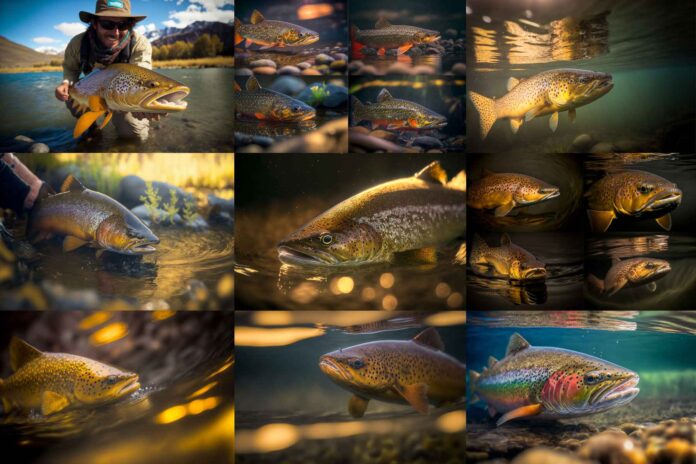Everyone loves fish photos. Well, most everyone. And high quality, creative, professional photos of fish, like it or not, are a major part of what this publication and others like it do. They’ve also become a core facet of the industry and sport of fishing as a whole. That fact is not without controversy. On one hand, catch and release advocates claim that fish often suffer at the hands of photo-hungry anglers that prioritize capturing a photo of their quarry over safe handling. There are many others that lament the fact that saturating social media with “epic” fish shots has become a form of currency, replacing outdated concepts of yesteryear, like knowledge, acumen and experience. Both of those problems are likely about to get much better, or much worse, depending on your perspective.
None of the fish you see in the images above actually exist. No one ever caught them and carefully posed them for the camera. They’re all the product of AI (artificial intelligence) image generation algorithms, platforms like DALL-E 2, Midjourney, Stable Diffusion, and others. AI image generation platforms like these have made striking advances over the last few years and, in many cases, it’s becoming difficult to tell the difference between photographs, pencil drawings, paintings, 3D renderings, and so on created by AI and those created by actual artists.
Of course that’s not always the case. There are some things these platforms are still particularly bad at. Generating images of fish happens to be one of them. Maybe you realized those images were fake at first glance, maybe it took a second look. But, without question, if you look closely, it’s pretty easy to tell those aren’t actual fish. Fish images the AI turns out are often riddled with anatomical and morphological oddities. And, as one angler I showed them to noted (after closer inspection), the fine details and textures are wrong — leading them to look sort of like fish mounts. So will anyone be confusing AI-generated grip-and-grins with the real thing anytime in the immediate future? Probably not.
Just a few years ago, however, the same could have been said for most anything these platforms generated—especially images of people. But these days, it’s quickly becoming hard to believe what AI is capable of. Take the image below, for instance. That old, grizzled, bearded fisherman doesn’t actually exist. I just asked the AI to make me an image of an old, grizzled, bearded fisherman and — voila!
Photo: AI.
This other fellow, who looks an awful lot like Bernie Sanders? Also doesn’t exist. But ask the AI to make you a photo of a fly fisherman that looks like the Vermont senator, and this is what you get.

Photo: AI.
What if you ask for something ridiculous? A request that you’re certain will get you pure junk in return. Something that, surely, no one has asked the AI to generate before … like a drawing of a Transformer standing in the water, “fly” fishing? Well, here you go.

Photo: AI.
Now there are certainly times when the AI gets things fabulously wrong. Feed it an image of a Kamchatka leopard rainbow trout and ask it to create you a few images of similar fish? That’s when things can go haywire.

Photo: AI.
But here’s the thing: as these platforms continue to train themselves by churning through millions if not billions of images they scour from the internet and as users continue to throw generation prompts and requests at these algorithms at a near-constant pace, they’re improving with staggering speed. Already, many of the images they churn out are strikingly good. So it’s likely that within a few years, subjects that currently confound these algorithms — like fish — no longer will.
That’s when the flood gates may open. Want to receive a rush of laudatory comments on your Facebook page after you post a photo of the 16 pound brown trout you convinced to eat the size 28 Adams that’s still stuck in its jaw? Just ask. Or how about boosting your Instagram following with an image of you cradling the monster tarpon you didn’t catch on the trip to the Florida Keys you didn’t take? Simply enter the prompt. Or how about one of that musky — the fish of 10,000 casts — that you “finally” landed on the preposterously gaudy, foot-long streamer that’s hanging out of its gaping maw? The AI will oblige.
Credit: Source link



























